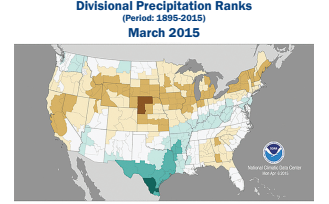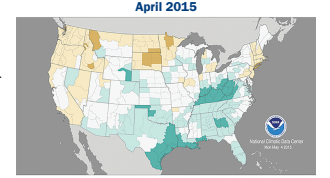A. Planting and Early Growth Conditions – Spring (March – May)
Warm, dry spring promoted early planting, followed by abundant rain

Weather factors impacting corn yield and quality include the amount of precipitation and the temperature just prior to and during the corn-growing season. These weather factors interact with the corn variety planted and the soil fertility.
Grain yield is a function of the number of plants per acre, the number of kernels per plant, and the weight of each kernel. Cold or wet weather at planting could reduce plant numbers, or hinder plant growth, which may result in lower yields per area. Some dryness at planting and early growth time is beneficial, as it promotes a deeper root system to access water later in the season.

Overall, for the key growing areas in 2015, March and April were relatively warm and dry for planting in the north and western areas, and wet towards the south and east of the central Corn Belt, delaying planting in key corn-growing areas. After a slow start, most of the corn was planted earlier than the 4YA. In May, the United States experienced its wettest month on record (over 121 years), much of it affecting the major corn-growing region.

More specifically, the majority of the Pacific Northwest and Southern Rail ECAs experienced a warm, dry period in March and April, followed by cool and wet weather in May, slowing crop growth and development.
The eastern half of the Gulf ECA experienced cooler and wetter than average weather in March, preventing early planting. By May, the eastern half was much warmer and drier than average. Elsewhere, pockets of abundant rains induced fertilizer loss, and plants in low-lying areas were flooded, causing patches of stunted plants within fields, decreasing the overall crop condition.
